JAPANESE BASEBALL CUSTOMS
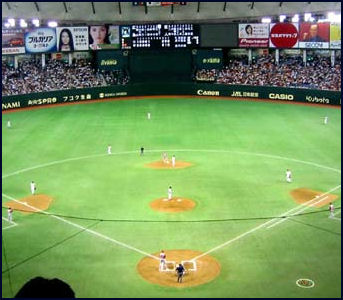
field at Tokyo Dome Hitters commonly touch or brush home plate after a home run to show respect for next batter. In the United States this would be interpreted as an insult to the pitcher. Players who hit a home run are handed a stuffed animal when they cross home plate. And, after the game fans stick around and listen to interviews with the players, broadcast at the stadium public address system.
Games are widely shown on television but they have to accommodate the television schedules. Games are routinely taken off the air before they are over — even if it is is a close, exciting game — to make way for the show that follows it. Games are sometimes delayed for a long period of time for the treatment of injuries.
There has traditionally is strong emphasis on building victories one run at a time using the sacrifice bunt. Many analyst say this style is out of date and if Japan sticks with it they do so at their peril.Jim Allen wrote in the Daily Yomiuri: “The game now is vastly different from the one played here 60 years ago, when home runs were scarce, averages were low and games were fast. With most hitters capable of putting a mistake into the seats, pitchers have to work more carefully than they used to. Higher averages mean more runners on base and longer games.”
In Japan three strikes has been an out since 1888, and four balls have been a walk since 1889.
Websites and Resources
Links in this Website: SPORTS IN JAPAN (Click Sports, Recreation, Pets ) Factsanddetails.com/Japan ; JAPANESE BASEBALL Factsanddetails.com/Japan ; JAPANESE BASEBALL RULES, CUSTOMS AND FANS Factsanddetails.com/Japan ; JAPANESE BASEBALL TEAMS Factsanddetails.com/Japan ; JAPANESE BASEBALL PLAYERS Factsanddetails.com/Japan ; JAPANESE MAJOR LEAGUE PLAYERS Factsanddetails.com/Japan ; JAPANESE MAJOR LEAGUE PITCHERS Factsanddetails.com/Japan ; ICHIRO SUZUKI Factsanddetails.com/Japan
Good Websites and Sources: Good Photos at Japan-Photo Archive japan-photo.de ; Pro Yakyu Now japanesebaseball.com ; Japan Baseball Daily japanbaseballdaily.com ; BaseballGuru baseballguru.com ; Japan Times Baseball Page japantimes.co.jp ; PBS Documentary on Japanese Baseball wbgu.org/community ; Japan Visitor japanvisitor.com ; Links and Baseball Cards robsjapanesecards.com ; Japan orama japanorama.com ; Wikipedia article Baseball in Japan Wikipedia ; Wikipedia article on Professional Baseball in Japan Wikipedia ; Pro Yakyu Forum, with Blogs and Discussions on Japanese Baseball japanesebaseball.com ; Sites That are a Little Old and Outdated But Still Have Good Info Jim Allen’s Japanese Baseball Page (old site) gol.com/users/jallen/jimball ; japanball.com ; Nisei Baseball niseibaseball.com ; Books: “The Mining of Ichiro” (2004), “ You Gotta Have Wa” (1989) and “The Chrysanthemum and the Bat” (1977) by Robert Whiting.
Articles on Japanese Baseball: Negative Impact of Japanese Success in the Major Leagues time.com/time/world/ ; World Baseball Classic worldbaseballclassic.com ; Early Days of Japanese Baseball international-baseball.suite101.com ; New York Times article om Japanese Fans travel.nytimes.com ; Baseball Hall of Fame Timeline on History of Japanese Baseball english.baseball-museum.or.jp ; Academic Paper on Japanese Baseball /www.economics.hawaii.edu
Japanese Baseball Teams: Yomiuri Giants Official Site (Japanese Language) giants.jp ; Wikipedia article on the Yomiuri Giants Wikipedia ; Hanshin Tigers Page www2.gol.com/users/michaelo/Tigers ; Hanshin Tigers Official Site (Japanese Language) hanshintigers.jp ;Hanshin Tigers Fan Page wallpaperman.tripod.com/Hanshin_Tigers_page ; Hanshin Tiger Blog tigerdude.com/japan/tigers ;
Koshien Stadium is the home of the Hanshin Tigers, a major institution in Osaka. Try to see a game if you can. The park is nearly always filled and the fans are fanatic as Red Sox fans except they pound plastic thunder sticks and do organized cheers throughout the game and set off balloons en masse in the seventh inning. Koshein is Japan’s oldest extant stadium. Built in 1924, it also hosts Japan’s main high school baseball tournaments, spectacles in themselves that can be viewed for free in the spring and summer.
Baseball Rules in Japan
The balls, bat and gloves used by Japanese players are pretty much the same as those used by American players. The Japanese baseball is smaller, more tightly wound and harder with bigger seams and said to be faster than the American baseball. The strike zone in Japanese baseball is larger, higher and narrower inside than outside the batter than the strike zone in American baseball and balks are rarely called.
The Japanese used to have a 2 and 3 count with two strikes and three balls as opposed to a 3 and 2 count. In January 2010, it was announced that Japan would start calling ball and strikes as the rest of the baseball-playing world does with a 3-2 full count.
The Japanese playing field is smaller and five teams have undersized fields. According to Japan League rules no game is permitted to go more than 12 innings. If a games is tied then the game is called a draw and generally is not replayed. One reason for this is to allow fans to catch their trains home after the game.
In the Central League, managers do not have to announce their line-up until 30 minutes before the game. This means that if one teams is expecting to face a right-handed pitcher, a manager can switch to left-hander and the last minute to confuse the opposing team.
A new ball produced Mizuno company was introduced in the 2011 season. Players complained that the low-impact balls as well as a wide strike zone changed the game by reducing home runs and lowering scoring. In the 2011 season only three hitters batted above .300 and there were far fewer home runs than in previous seasons.
Japanese Umpires
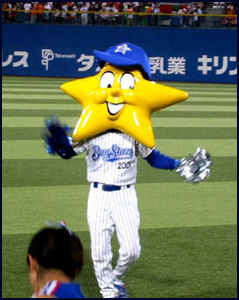
Yokohama Baystars mascot American umpire generally spend 8 to 10 years in the minor leagues before they move up to the major leagues. In Japan, some umpires begin working in big league games shortly after completing a five week training course in America.
Japanese umpires endure more insults and physical abuse than their American counterparts, and behavior that would get an American major league player ejected, fined or suspended is tolerated in Japan. If a catcher feels that a umpire makes a bad a call, he'll roll around on the ground in mock agony.
The first non-Japanese umpire to ever work in the Japanese league, American Mike DiMuro, lasted only three months into the 1997 season before he quit. DiMuro was berated by a pitcher for calling an obvious balk and punched on chest by a batter he had been ejected from the game. The batter was give a letter of reprimand. After that incident Di Munro told the Washington Post, "What will the next guy be allowed to do if I call a strike — take bat to my head?"
Disputed Calls and Umpires in Japan
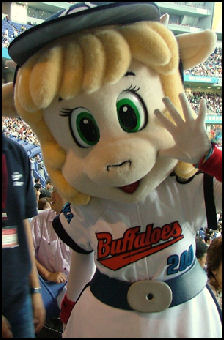
Orix Buffalos mascot Japanese umpires sometimes have conferences that last up to 30 minutes and then reverse the call with the head umpire getting on the public address system and explaining the call the apologizing to the fans. In 1999, one umpire made a call which outraged the fans. That night at home he saw a replay of the play and realized he was wrong. He then suspended himself from play to "refresh his mentality." Play in the 2004 Japan Series was stopped for about an hour over a disputed call involving a double play.
Describing one incident in a game between the Nippon Ham Fighters and the Seibu Lions, Kevin Sullivan wrote in the Washington Post, "A Lions player hit a fly ball that struck a hand rail atop the outfield wall and bounced back onto the field. The umpire closest to the play called it a home run. The Ham Fighters ran onto the field, manhandled the umpire and disputed the home run call. All four umpires working the game held a conference on the field. After much discussion, the chief umpire ruled the ball a ground-rule double."
"Enraged by the reversal," Sullivan wrote, "the Lion's manager then charged onto the field and hit the chief umpire with his forearm. A long discussion ended in which the Lions suggested a compromise solution: call it a triple. The umpire agreed. The chief umpire told the crowd: 'We apologize for mishandling this case and the delay in the game.'"
In July 2004, four Central league umpires received harsh warnings after they mistakenly awarded a batter a walk on only three balls.
Long Baseball Games and Energy Saving Rules
In terms of innings, Japan's longest game came on May 24, 1942 when Nagoya and Taiyo played to a 28-inning, 4-4 tie in 3 hours 47 minutes. In contrast, 57 nine-inning games during the 2010 regular season ran longer than that. In November 2011, Chiba Lotte Marines and Chunichi Dragons played a Japan Series game that lasted 5 hours 43 minutes. Not only was it the longest Japan Series game ever, but it was also the longest ever played by a Pacific League team.
Jim Allen wrote in the Daily Yomiuri: “This beauty might have gone on and on and on, but it was halted at 15 innings. What might have become the longest pro game ever ended in a tie. The tie created the possibility of a Game 8 on Monday or even a Game 9 (had the teams tied Sunday and the Dragons won Game 8).
"I expect these extra-inning ties will disappear eventually," Chunichi manager Hiromitsu Ochiai said just after midnight in his postgame press conference. "It's kind of like I said before. The way things are set up now, we could tie the first seven games and end up having to play 14."
In 1986, there was no limit to the number of extra innings, but none could start 4 ½ hours after the start of play. That rule died after Game 1 in 1986 was declared a tie at 5:32 p.m. on a Saturday afternoon with the Seibu Lions and Hiroshima Carp tied 2-2. Seibu lost the next three games, but clinched in the only Series Game 8 ever played. From 1987, Series games could go 18 innings before being declared a tie. When night games were introduced from 1994, the inning limit was reduced to 15.
In December 2012 Kyodo reported: “Nippon Professional Baseball's 12 teams discussed scrapping the "3½ hour" energy-saving rule at an executive committee on Monday, but no conclusion was reached. The rule, enacted due to the energy shortage following the March 11, 2011, earthquake and tsunami, prohibits the start of a new extra inning more than 3½ hours after the start of play The Central League's board of directors agreed to do away with the rule for next year, but no consensus was achieved among representatives of the Pacific League teams. There were 74 tie games in NPB this past season and 56 in 2011, up from an average of 18 a year from 2005 to 2010.
Japanese Baseball Fans and Stadiums
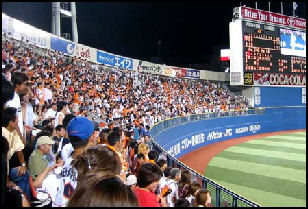
Fans at a Baystars game During the games, Japanese fans release balloons, bang plastic clappers, and wave flags. Giant screens show the instant replays and pink and white fireworks are shot into the air after a home run. When a foul ball is hit into the stands, fans don't fight to get their hands on it. Instead, a young girl ushers blows whistles to warn spectators to look out. The person who recovers the baseball hands it over to the usher, who returns it to the home team. [Source: Sports Illustrated]
Describing a Seibu Lion fan Bryan Walsh wrote in Time, “Clad in a powder blue Lions jacket, with a Lions towel wrapped around his neck, Koile spends the entre game bobbing like a prize fighter in Seibu’s official cheering section, where well-drilled fans in blue and white drum and single personalized anthems every time a Lion comes to bat.”
During Japanese baseball games ushers in the spotless stands walk up and down the aisles to collect trash passed over from the fans. Beer, whiskey vodka and shots of Chivas Regal are sold by vendors (sometimes with a beer tank on their back), and from vending machine and snack bars. along with shrimp tempura, squid snacks, noodles, rice balls and pea-flavored snacks.
During the seventh inning at some games all the fans collectively release colored balloons. When the games are over the fans don’t make a beeline to the parking lot they hang around to listen to the post game interview given by the star player over a public address system.
Japanese Baseball Cheerleaders
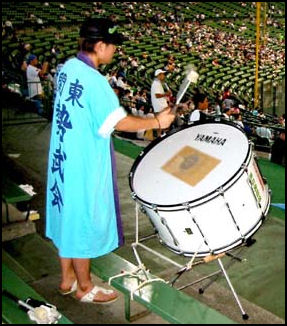
In the bleachers, paid cheering squads, often decked out in yukata and hopi jackets in the official team colors, bang drums, blow horns, clap plastic bats, sing personalized fight songs, and yell and chant into plastic megaphones when they are instructed by male cheerleaders who wear white gloves, stand on small platforms and blow whistles and look like traffic policemen as they direct cheers.
When players from the opposing team are at bat the cheerleaders quietly take their seats while the cheerleaders for the other team take their turn. The cheerleaders have tryouts and practices; ones that can’t sing or shout so well become designated clappers.
Many of the cheers are scripted and the fans are expected to follow them in unison. Some teams issue lyric sheets before the games. The job of the cheerleaders is make sure everyone os one cue. A typical cheer goes like this: “Cut trough the roaring thunder with you swing! Bark! Fight! Advance towards glorious victory!” each player has his own individual song. [Source: Washington Post]
The yakuza are reportedly deeply involved in baseball cheering groups, and use connections through the groups to obtain good tickets for scalping and reportedly even extort money from food vendors.
Japanese Baseball Analysts

fans let off balloons Commentators use sophisticated computer studies to analyze players and have long discussions about blood types and performances. Japan newspapers run ten-column box scores, with batter-by-batter accounts of every game and complex player-ranking formulas. Astrologers sometimes predict winners based on the position of Mars.
The Japanese media is not allowed in the clubhouse. The postgame "interviews" consist of a few predictable sentences distributed by a public relations person.
Jim Colorn, a pitching coach for the Los Angeles Dodgers, told the New York Times, “They idolize technique and skill in Japan more than Americans do. How you do something is paramount in Japan. Here, it more about achieving the numbers. Power is the American way.”
Japanese journalists and fans particularly get into one-on-one battles, particularly between batters and pitchers. A book called “Ultimate Baseball Theory” by Seijun Ninomiya focuses on famous pitcher-batter showdowns and spend six pages covering the first showdown between Matsuzaka and Ichiro.
Brad Lefton wrote in the New York Times, “The Japanese way is to revel in the intricacies of the pitcher-batter match up. In Japan, talented pitchers and productive hitters are thought of in tandem. Mention Hideo Nomo from his days with the Kintensu Buffaloes and without hesitation most fans will associate him with hard-swinging Kazuhiro Kiyohara,..In Japan...it’s the process that is appreciated. Results can be secondary to the tactics one individual uses in dueling another. Such preoccupation with an individual performance smacks against the image of Japan as a group society. “
On the questions he field from Japanese journalists, Boston Red Sox catcher Jason Varitek told the New York Times, “We’re more end result. Rather than what are the little things that went into the whole entire outcome, we’re like, “Ok. He gave up a three-run home run.: “They’re like, “Why did he throw 15 change-ups today and 5 last time?” They’ll talk about the sequence. “Why does he throw so many sliders today?...Their way of watching a game is different.”
Japanese-Style Playing
Japanese baseball analysts often criticize American managers for their tendency to limit pitch counts in training. The Japanese have long favored a regimen aimed at developing muscle memory that allows pitchers to throw as much as they feel necessary, even for relievers who sometimes face only one batter in a game. [Source: Brad Lefton, New York Times, August 24, 2010]
Fielding a ball backhanded has long been considered taboo: Japanese players are taught that reaching across their body for a ball is unacceptable and squaring their feet up to the ball is the only proper way to field. “Backhanding a ball doesn’t mean you’re lazy,” Marty Brown, an American who managed Japan League teams in Hiroshima and Sendai, told the New York Times. Brown had to work hard to sell the idea to his his team. “You’ve still got to move your feet and get to a ball and backhand and set your feet and throw. That’s something you need to practice because it’s going to happen in a game.”
The practice-happy Japanese are big on swing repetitions. Young professional Japanese players are notorious for taking extra batting work at the team hotel during spring training. They find space in the bowels of the hotel, on its roof or in a spare conference room. “You can never say here in Japan, “I didn’t get enough,” Matt Murton, a former Major Leaguer who plays for Hanshin told the New York Times. “If there’s more to be had, they’re going to give it to you.” [Source: Brad Lefton, New York Times, May 13, 2011]
Team slogans, a popular tradition in Japanese baseball, are often illogical strings of English words such as “Hit! Foot! Get!” or “Full Season, Full Power Analyzing Baseball.”
Japanese Baseball Coaches and Managers
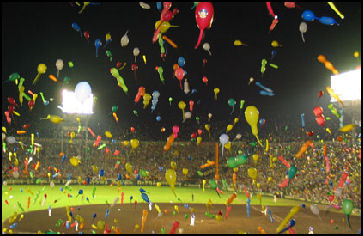
Japanese teams have twice as many coaches as American teams and Japanese coaches are treated with the reverence of a father figure and their authority is more absolute than their American counterparts. Japanese coaches routinely strike lazy players, make pitchers with sore arms keep throwing, hire detectives to keep on eye on flamboyant players, and fine players who criticize management. One pitcher, who was punched between the eyes by his coach for ignoring the coaches advice, was fined and forced to apologize not the coach.
Tetsuhara Kawakami, the coach who lead the Giants to nine straight Japanese championships, told Whiting: "Most players are lazy. It's the manager's responsibility to make train hard. Courteous players make for a strong team. It's the manager responsibility to teach them manners...Leaders who are thought of as 'nice people' will fail. Lone wolves are the cancer of the team."
Some managers are known for their temper. When Senichi (Burning Hat) Hoshino was with the Chunichi Dragons he grew so frustrated during a losing streak he pinched players in the face if they made mistakes.
Japanese Baseball Ma and Wa and Honor
Japanese baseball emphasizes self-sacrifice, discipline, purity of heart, heavy-handed coaching, endless training, form over flair, caution, strict corporate control, and features lots of sacrifice bunts, on-field conferences and ponderous strategy sessions’summed up by the concept of “doryoku” (“unflagging effort”) which the great Japanese player Sadaharu Oh wrote on every autograph.
The slow pitch-by-pitch tempo has been compared to the dramatic use of “ma” (pauses) in Kabuki Theater. Explaining the success of a relief pitcher, one baseball analyst told Whiting, "he was good because he knew how to use the “ma”. He waited for just the right moment — a momentary lapse of concentration by the batter — to deliver his pitch." [Source: Robert Whiting, Smithsonian magazine, September 1986]
Japanese baseball also stresses “wa”, or team harmony. Players who ask for a raise are often traded instead and players who refuse their salary because the missed games as the result of an injury are held up as paragons of virtue. In his book “You Gotta Have Wa” (1989) Robert Whiting, wrote “If you asked a Japanese [baseball] manager what he considers to be the most important ingredient for a winning team, he would likely answer wa. If you asked home to knock a team’s wa, he would probably say “Hire an American.”
In 2000, Katsutoshi Miwata, the chief scout for the Orix Blue Wave, committed suicide by jumping from an 11-story building because he failed to sign his team's top draft pick.
In 2001, home run king Sadaharu Oh was almost banned from baseball for life when he was a coach after three members of his team were implicated in a sign stealing scandal. The players were accused of stealing catcher signs by watching the clubhouse television and relaying messages to hitters with the help of someone in the stands. Under Japanese rules the players can be punished for such an offense with a lifetime suspension as can the manager even if he didn't know about the offense.
Rules for Japanese Baseball Players

player interview before
fans after game Some teams have rules that prohibit their players from wearing short pants in public, sporting certain hairstyles, and reading certain comic books out of fear it will spoil the team's image. Some teams also have strict midnight curfews; require young players to help take gear off the field; and confine players to their rooms as punishment for a bad play.
Some coaches force their players to eat a strict natural-foods diet of fish, soybeans, brown rice and tofu salad, and to attend two months "autumn camps" — with a nine-hour regime or swimming, aikido (a Japanese martial art) and immersion in icy mountain rivers — right after the end of the season.
Players in championship games are sometimes sequestered from their families while playing at home and are ordered to keep the curtains of their hotel rooms closed out of concern that the other team might be spying on them.
Japanese Baseball Training
In the early years of Japanese baseball, players ran drills with massive kanji dictionaries strapped to their backs, catchers were taught the correct way to crouch by squatting over a over a bunch of spikes, and players were motivated with slogans like "Practice till you die" and "Bloody urine."
A popular drill, only recently been abandoned by many coaches, called the “senbon-nokku” ("thousand knocks"), required players to catch balls until they collapsed from exhaustion. It is still not uncommon for Japanese players to puke their guts out at the end of practice.
In a typical practice players hit fungos and pitchers hurl 200 pitches, "The Japanese," writes Whiting, "believe that good players are made, not born, and that only through endless training, strictly supervised by coaches, can one achieve the unity of mind and body necessary to excel." [Source: Robert Whiting, Smithsonian magazine, September 1986]
Japanese players practice year round, sometimes for seven or eight hours a day, and attend endless meetings, while their American counterparts have five months off in the off season, show up at only a handful of meetings, and practice only four hours during the six week pre-season training camp. One American player who played in Japan said, "It is the difference between summer camp and a year in the Imperial army."
Teams continue with tough practice even when it is very hot and humid and the team has not chance of winning the pennant or have already clinched it. To do anything less would be unJapanese. Former Major Leaguer and Hanshin player Matt Muron, told the Daily Yomiuri, “One-hundred forty-four games here might be more difficult that 162 in the states, because there’s practice every day. There’s always something all the time. We [foreign players] don’t have it figured out by any means, but at times we can scale back on practice.”
Jim Allen wrote in the Daily Yomiuri, “This started in the 19th century when players from the First Higher School of Tokyo became national heroes by repeatedly beating teams of foreigners. The teams spartan training became as famous as their victories, and the act of preparation was elevated to a goal unto itself.”
The rigorous training regimen has been relaxed somewhat. Japanese players can now can get drinks of water if they want and pitchers are no longer required to throw 4,000 to 5,000 pitches in the preseason to build up their strength and spirit. Now they only throw about 1,000 pitches.
Burnt Out Japanese Pitchers
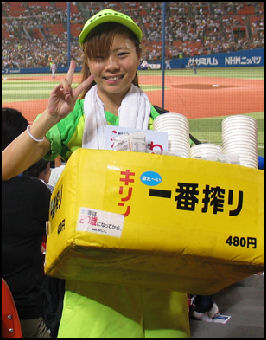
Yokohama beer girl Japan has a reputation of burning out pitchers too soon. After the season when most pitchers on th Major Leagues take a vacation, pitchers in Japan keep up a rigorous training program sometimes throwing more than 200 pitches a day, more than American pitchers throw during a week during the off-season.
Japanese pitcher have often been throwing hard and often since they were 12. An American who played in Japan told the International Herald Tribune, “They throw easily two or three times more pitches in their career than Americans. They play 360 days out of the year. It’s taken to an extreme that you don’t see in America.”
It is not unusual for a star pitcher to throw six inning in one game, then come out of the bullpen in the tenth inning two days to save a game and throw 167 pitches two days later in important game. One Japanese pitcher told Sports Illustrated: "In America, pitchers look for help when they get close to about 100 pitches. In Japan we value a complete game more." [Source: Tom Verducci, Sports Illustrated]
The Japanese pitching philosophy is sometimes described as "Throw until you die." According to one survey only 25 percent of Japanese pitchers are still playing at the age of 30, compared to 40 percent in the U.S. Among Japanese pitcher that played in the United States, Nomo was released at age 30, Irabu was finished at 33 and Kaz Ishii was done at 32.
Bobby Valentine, who coached in both the Major League and the Japan League, takes a different view. While he said that overthrowing is a “definite problem,” he told the International Herald Tribune that the superior mechanics of Japanese pitchers may help them avoid injury. “Pitchers in Japan are taught at an early age what proper form is. They’re less prone to injury than in America where they deal with results rather form.”
Valentine told Sports Illustrated, “I’m convinced we’ve done a bad job of coaching in the U.S. for pitchers...Japanese pitchers have...wonderful balance and a core foundation of strength, They work the small muscle groups, [Americans] work the large ones. The large ones make you “look” better.”
Power in Japanese Baseball
The teams are often run by executives with large corporations. In many cases they have no particular background in sports but are rather distinguished themselves as company yes men and were rewarded with position in charge of the baseball division. Masayuli Tamaki, a sports critic, told the New York Times, “The baseball teams’ presidents are people who are dispatched to the teams from their parent companies for two, three years.” He said they often have little interest reforming or revitalizing baseball, “What they do is spend their time getting autographs to present them as gifts to bar girls.”
There is no real commissioner. The most power group in Japanese baseball is the owners committee. The most powerful position is the chairman of the owner’s committee.
The Pacific League gets relatively little television coverage. In 2005, Japan’s Cental and Pacific Leagues had their first inter-League games,
Salaries, Unions, Strikes and the Draft in Japanese Baseball
Salaries have climbed dramatically in the past two decades. In 1985 the minimum salary for players was $18,000, now the average salary is over half million dollars. The highest salaries in Japanese baseball are about $5 million a year (See Kanemoto, Players). The highest salaries in the Major League are about $15 million a year.
Teams generally take a cut of players’ endorsement money and refuse to give players pension plans or insurance. The Japanese Players Union, formed in 1985, has little power. Most players have traditionally said that a strike would never happen in Japan yet there was one in 2004. See 2004 Strike, Changes in 2004 and 2005 Below
Japanese players become eligible for free agency after ten years of playing for one team. In 1995, only nine of the 200 or so players eligible for free agency changed teams. Players like to stick with their team because after they retire from playing they usually can expect to get a job within the team organization. But not all of these jobs are good. A former Major League pitcher, playing in Japan, told Sports Illustrated, "We have a former five-time All-Star picking up laundry in the clubhouse."
In Japan, players are drafted after they finish high school and the system is set up in such a way that drafted player can refuse to play with the team that drafted them, play three years in with a company team, and then play with the team of their choice. In 1998, a personal director for the Orix Blue Wave committed suicide after he was a unable to get hot prospect his team had drafted to sign a contract.
Problems with Japanese Baseball

Giants beer girl Baseball could be marketed much better in Japan in such a way that it would bring more money to the teams and more enjoyment to fans. With television for example, the rights are sold game by game by the home team rather collectively through the leagues. Under this system popular teams such as the Giants and Tigers do well — it is not unusual to see their games broadcast at the same time on three different channels — while less popular teams suffer.
Japan lacks a decent minor leagues, denying clubs of an opportunity to develop new and promising talent. Only one farm team is allowed for each clu, Team owners refuse to cooperate on marketing and revenue sharing.
In December 2004, the Baystars and the Tigers were fined over their effort to recruit an ace university player essentially by bribing him. In March 2007, a Waseda University player Katsuhito Shimizu admitted he made a secret contract while in high school with the Seibu Lions. It was revealed that Seibu paid ¥61.6 million to five other amateur players in addition to Shimizu. In 2005 Seibu’s owner was convicted of insider trading and given a 20-month suspended sentence.
Mergers and Strikes in Japanese Baseball
In 2004 The Orix Blue Wave and Kintensu Buffalos merged into a single team, the Orix Buffalos. Both teams were deeply in debt and having a hard time drawing many fans to their games. The merger took place after a so-called Internet whiz kid, Takafumie Horier, tried to take over the Buffalos. Around the same time a new team was added, the Sendai-based Tohoku Rakuten Golden Eagles, sponsored by the Internet trading business Rakuten Inc. The new team was godsend because without it there was talk of dissolving the existing Central and Pacific Leagues and creating a single league. In 2005, Softbank purchased the Daiei Hawks when the Daiei retailer was having troubles and renamed them the Softbank Hawks.
In September 2004, Japanese players went on strike for the first time, for two days, over the Orix-Kintensu merger and the initial reluctance of owners to allow a new team. and the negative impact of this on the players. A second strike was averted. The dispute was settled when the owners promised to speed up the process for allowing a new team into the league.
The strike and the activities that occurred around it resulted in the loosening of the grip on power by secretive owners and allowed an injection f new blood and new ideas. Softbank owner Masayoshi Son advanced the American the idea that players were underpaid and that money was no object in building a winning team.
Japanese Baseball Slump
Total attendance dipped from 23.4 million in 1992 to 22.7 million in 1993, and then declined 7 percent more in 1994. making matters for sports club owners is the fact that cheap tickets sell well but the expensive seats are empty. It is not unusual for a stadium with 50,000 seats to have only a few thousand of them filled. Teams have also suffered from declining television audiences.
Analysts attribute the slump to baseball to the length and lack of action in the three-to-four-hour games, expensive tickets ($25 bleachers and $70 box seats), the lack of attention grabbing stars, the economic downturn and the loss of a large number of its young fans to soccer.
"Japan is like the zebra that can't decide if it's black or white," says Whiting. "You keep hearing that the youth won't put up with the old ways anymore, but tradition dies hard."
Bryan Walsh wrote in Time, “Pro baseball is seen as stagnant and uncompetitive, clinging blindly to by gone success, which makes it a fittingly miserable metaphor for much of Japanese society — enslaved into tradition as its struggles to break out of years of economic gloom.” Valentine said, “I think the read danger now is that Japan is closer to becoming the second coming of the Negro leagues.”
In an effort to lure spectators teams are offering packages with pizza and Japanese-style pancakes and all the beer you can drink. Hiroshima Carp uses a “baseball dog” with a basket to deliver new balls to the umpire.
Impact of Players Leaving Japan for the Major Leagues
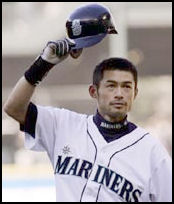
Japanese have been pleased that their players could find success in the Major Leagues but are also worried about robbing the Japan League of talent. Already the television audience and stadium attendance for Japan League is declining. After Ichiro left the Orix Blue Wave the team’s attendance figures went down 47 percent.
Japanese baseball fans watch Major League broadcasts with Japanese players on television in the middle of the night and ignore Japan League games that are during prime time. The activities of Japanese players in the Major Leagues are given top billing on the evening news and reports about the Japan League are given almost as if they were an afterthought.
Mariners and Yankee T-shirts are more visible of Japanese city streets than Yomiuri Giants of Hanshin Tigers ones. So many Japanese visit Seattle, Los Angeles and New York to see the star players that stadiums there have signs in Japanese.
To prevent a loss of talent, Japanese Professional Baseball is considering a rule that would penalize any player who plays abroad or in a corporate league by requiring them to not play for two or three years should they decide to play baseball in Japan’s top leagues.
Image Sources: Japanball.com except Ichiro, Giants win and Kiyohara
Text Sources: New York Times, Washington Post, Los Angeles Times, Daily Yomiuri, Times of London, Japan National Tourist Organization (JNTO), National Geographic, The New Yorker, Time, Newsweek, Reuters, AP, Lonely Planet Guides, Compton’s Encyclopedia and various books and other publications.
Last updated January 2013
